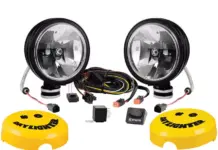Author: Honda
Date Published: 2021
Link: https://csr.honda.com/longform-content/environmental-impact/
At Honda, we take great care to consider the environmental impact of everything we do, and everything we make. From being a leader in the fuel economy of our fleet of vehicles to powering our US manufacturing operations with renewable energy, we are focused on a sustainable future. These efforts include transparent reporting of our environmental performance in the North American region and globally.
As the largest manufacturer of engines in the world, we strive to ensure those engines – as well as the products they power – are clean, fuel efficient and emit the least possible emissions. This commitment drove Honda to be one of the first companies to declare its own Environmental Statement in 1992. In 2011, we went one-step further when we issued our Environmental and Safety Vision.
Environmental Goals
2030 Goal
In 2016, Honda announced it would rapidly advance the deployment of electrified vehicle technology throughout its product lineup.
2040 Goal
In 2021, Honda announced key targets for sales of electrified vehicles in North America, with a plan to make battery-electric and fuel cell electric vehicles to represent 100% of its vehicle sales by 2040, progressing from sales of 40% by 2030 and 80% by 2035. To accelerate toward these targets, Honda plans to launch a series of new EV models based on the company’s new e:Architecture, beginning from the second half of the decade.
2050 Goal
Honda will strive to realize carbon neutrality for all products and corporate activities by 2050. Striving for “zero environmental impact” of its entire product lifecycle and our corporate activities, Honda will focus on the following areas as the “three-pillars” of our initiatives:
- Carbon neutrality
- Clean energy
- Resource circulation
- Honda will also expand the range of electrified products with its Honda Mobile Power Pack swappable battery, and expand utilization of renewable energy by enabling infrastructure-linked smart power operations.
- Furthering its use of renewable energy, Honda will proactively promote the utilization of hydrogen, and will strive to realize a “multi-pathway of energy,” which is a concept of utilizing a wide variety of energy sources including carbon-neutral fuels. This will be effective in all product areas, including where electrification is difficult, such as with aircraft.
- Honda is pursuing research on material recycling and will take on the challenge of developing products made from 100% sustainable materials.
Environmental Management
Life Cycle Assessment
Life Cycle Assessment (LCA) is a critical tool for understanding the impact of our products and operations on the environment.
The LCA process consists of six distinct areas for means of identifying opportunities to reduce the environmental impact of operations: Development, Purchasing, Manufacturing, Sales & Service, In-Use and End-of-Life.
What follows is a breakdown of our environmental results from Fiscal Year 2020 across Honda’s North American facilities.
Product Development
Every phase of the design and development of each Honda and Acura product considers environmental factors. Honda engineers account for such factors as dismantling complexity, component remanufacturing and the minimization of substances of concern.
Product Recyclability
Honda is committed to maintaining a minimum 90% level of recyclability for all Honda and Acura automobiles. Honda and Acura have met the 90% target in all new products since 2004.
Waste
Better use of raw materials eliminates waste at the source. That’s why Honda strives to implement reuse, recycling and energy recovery to avoid sending waste to landfill.
- Total waste was down 6.2% last year to its lowest levels in six years, while solid waste per auto decreased 3.6% from one year ago.
- Honda’s North American manufacturing plants were 98% landfill free in FY2020, with a goal of 99%.
End-of-Life
Recycling programs for many automobile parts are key components of Honda’s waste-to-landfill strategy in North America. Honda prevented more than 46,700,000 pounds of waste material in FY2020 from going to landfills.
This article gives us a detailed summary of some of the sustainability practices and goals that Honda is currently implementing. It will be important for us to align our project with their practices and to be aware of any relevant transitions coming up in the future, as well as to understand the sustainability-related constraints we’ll face as we head into the initial stages of concept development. Though there were several more mentioned in this article, they were relevant to primarily production and manufacturing related statistics; the ones featured here are likely the most relevant to our position as student designers.
Measuring Honda’s environmental impact. Honda Corporate Social Responsibility. (2021, July 15). Retrieved September 17, 2021, from https://csr.honda.com/longform-content/environmental-impact/.




